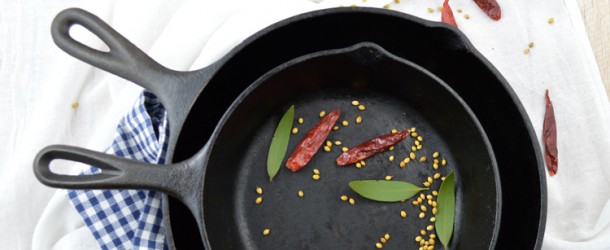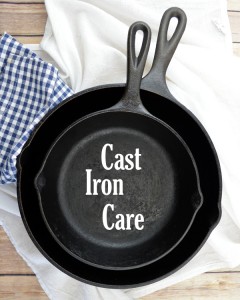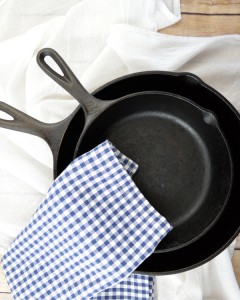Congratulations on your new baby! Your new cast iron pan. You’ve brought it home after much deliberation – buy it? don’t buy it? the dilemma! – but now you are the proud owner of a piece of iron that you have heard will result in a non-stick cooking surface, at least after a little bit of time.
I’ve been using cast iron pans for about a decade and have the pleasure of being able to cook pancakes, tofu and vegan omelets without the need for much fat, something I cannot do with any sort of success in a stainless steel skillet.
Not only is a cast iron pan great as a cooking surface once seasoned, it is a heavy piece of vessel that I find oddly comforting. It holds heat well and with more consistency than any other pans I have and, for the occasional pan frying, nothing beats it.
More than likely, your new cast iron pan is pre-seasoned (or at least it claims to be), but I’m not a big fan of factory seasoned cookware, so it is important to wash your pan in hot soapy water. This is more than likely the last time that your pan will be washed in soapy water, so make it count.
Contrary to your innate instincts, once seasoned, cast iron should not be washed with anything stronger than water. Once you season your pan, it will develop a patina, or a coating, on the surface which will be scrubbed away with soap and water, rendering your pan UN-seasoned. We don’t want that to happen.
I remember the incredulous look on my husband’s face when I first tutored him on the proper cleaning methods of our new cast iron baby. It has taken a while for him to reconcile with this new way of cleaning a pan, but we are both on the same page now and relish the dishes that the pans produce.
What exactly is “seasoning the pan?” It isn’t a way of adding salt and pepper. It is a way to create a coating on the surface of the cast iron by sealing the porous pan with a type of fat. The fat burns into the pan during cooking and creates a seal.
Let’s get to down business:
How to Season or Re-season Your Cast Iron Pan:
1. Wash your pan in hot soapy water.
2. Dry with a towel.
3. Rub the pan liberally with vegetable oil (grapeseed, coconut or sunflower are good choices), inside and out.
4. Place the pan upside down on a baking sheet.
5. Bake in a 350-degree oven for about 1 hour. Allow to cool.
How to Care For Your Cast Iron Pan:
1. Use at least a little bit of fat each time you cook. Over time more patina will coat your pan, therefore requiring less and less fat needed for cooking.
2. Clean your pan after use.
3. After each and every cleaning, heat the pan over medium heat until thoroughly dry, about 3 to 5 minutes. If your pan is losing some coating, rub the pan with a teaspoon of oil using a paper towel.
4. After storing your pan without use for a long period of time, wash in soapy water and re-season. The oil used previously to season your pan could have spoiled and that is not good eats.
How to Clean Your Cast Iron Pan:
1. Remove all food from your pan.
2. Wash in warm or hot water (no soap), using a kitchen towel or plastic scrubber.
3. If you have stuck on food, add water to the pan and soak for 5 minutes. Use a steel wool to clean off the burnt on food, but do not(DO NOT) scrub with the wool. Only barely wipe the wool over the pan. This takes a gentle hand as you do not want to scrub away your hard work; you only want to remove the stuck on food. This is how I clean my pans every time – just a gentle brush with the steel wool, barely touching the pan itself.
4. Do not submerge your pan in water as you will remove coating from the bottom of the pan and will need to re-season to avoid rusting on the bottom.
5. Don’t forget to heat the pan for 3 to 5 minutes to evaporate all possible liquid that could cause it to rust.
Tips:
1. A small skillet is great for toasting spices, nuts and making single serving sandwiches.
2. Your largest skillet should not be larger than your largest stovetop burner, otherwise you will have cool spots in your pan, which will drive you nuts.
3. If you use metal spatulas (I do), be gentle and don’t jab into the pan. If you need to scrape food off the bottom of the pan (the sucs or fonds), use a sturdy wooden spatula.
4. If you cook lots of liquid in your pan (such as gravy or sauce) make sure you rub the pan with a teaspoon of oil after the cleaning as the cooking liquids tend to remove some seasoning.
5. Your cast iron will need to be preheated for a few minutes before it is actually heated through and ready for use. Plan accordingly.
That’s it! Once you get into a routine with your pan, you will find yourself reaching for it repeatedly, over any others. I keep mine right on the stovetop, as I use them continuously. And I do mean “them” – I have a small skillet, a 10-inch skillet and a grill pan. Once you experience the true benefits of a cast iron pan, any others just won’t cut it.


